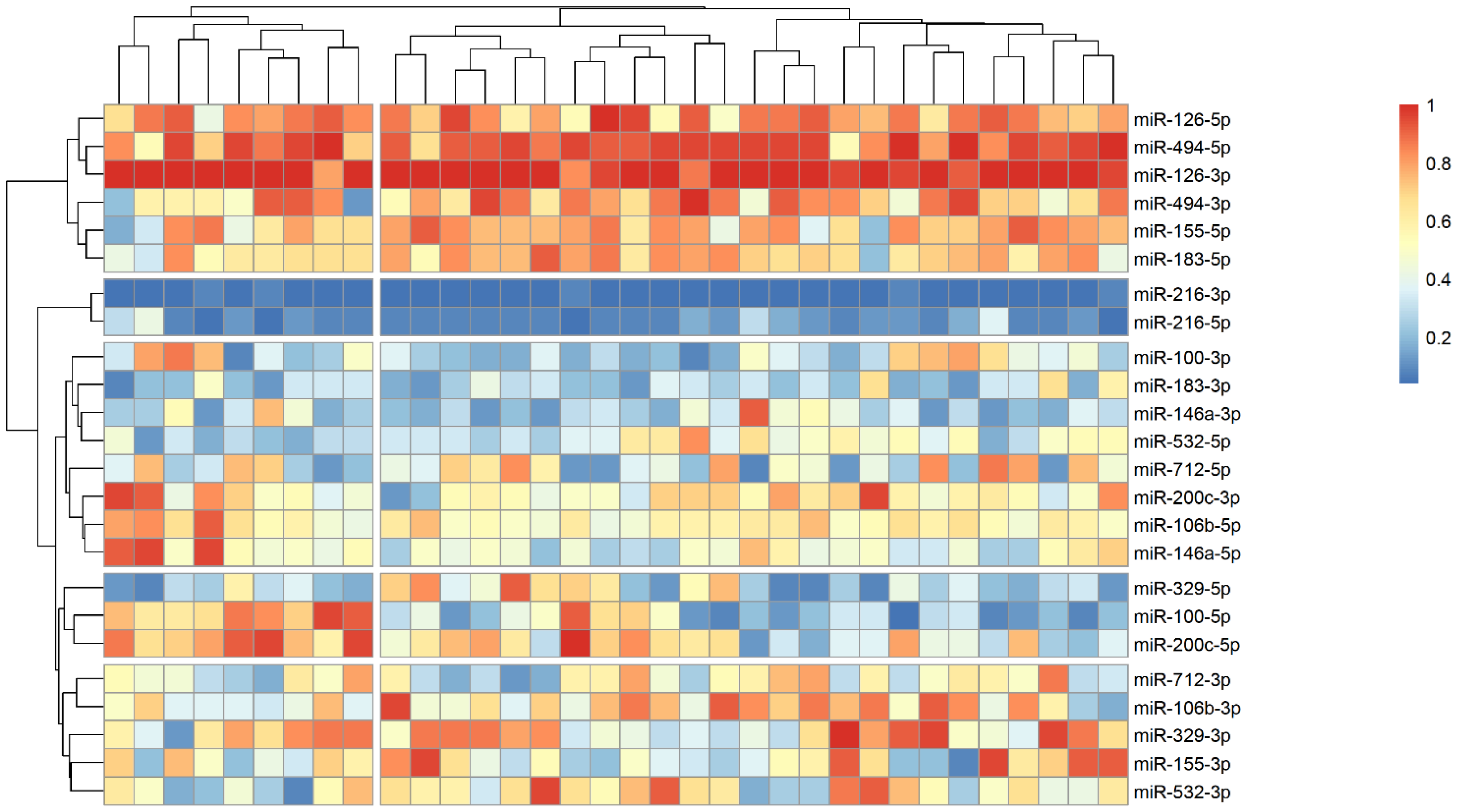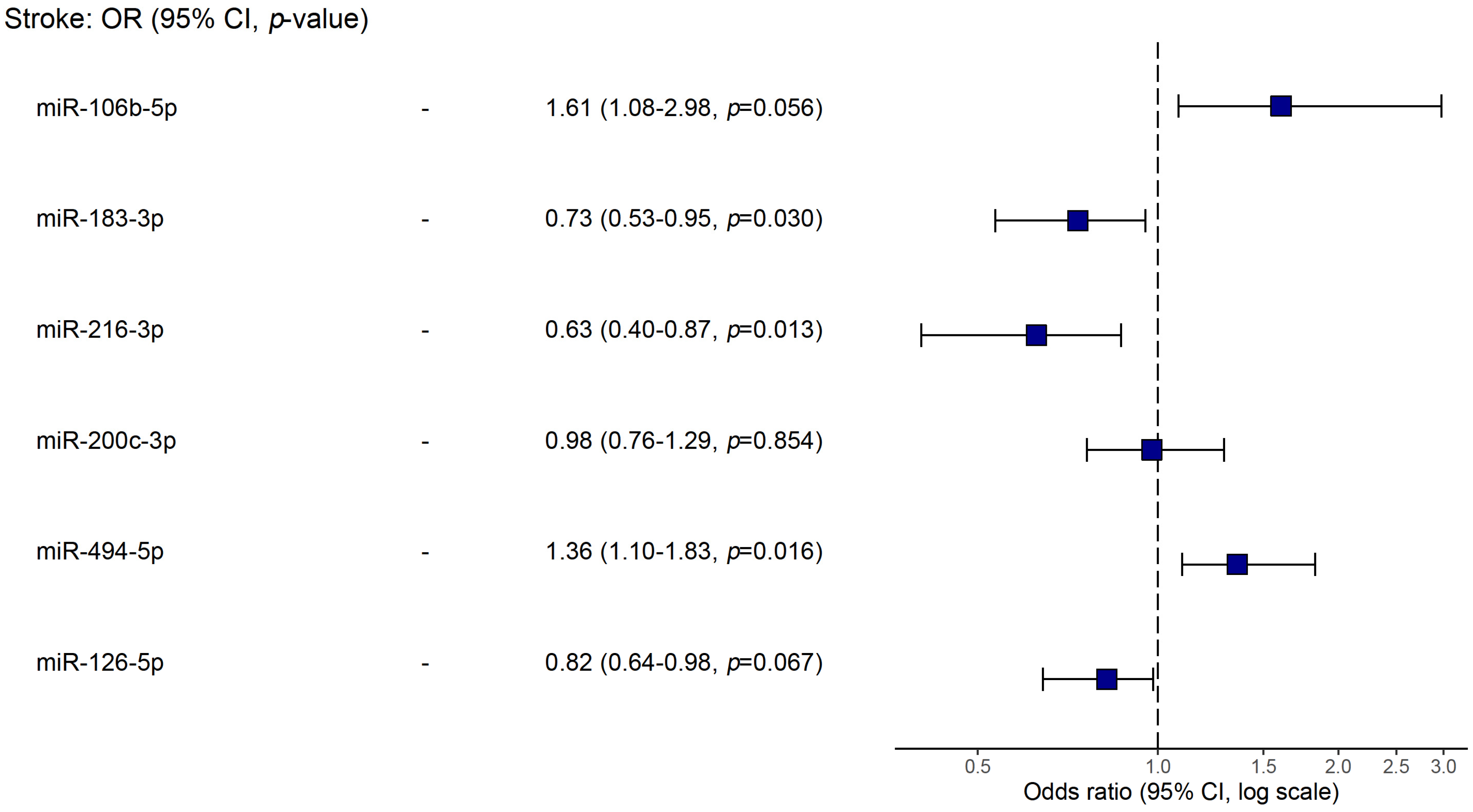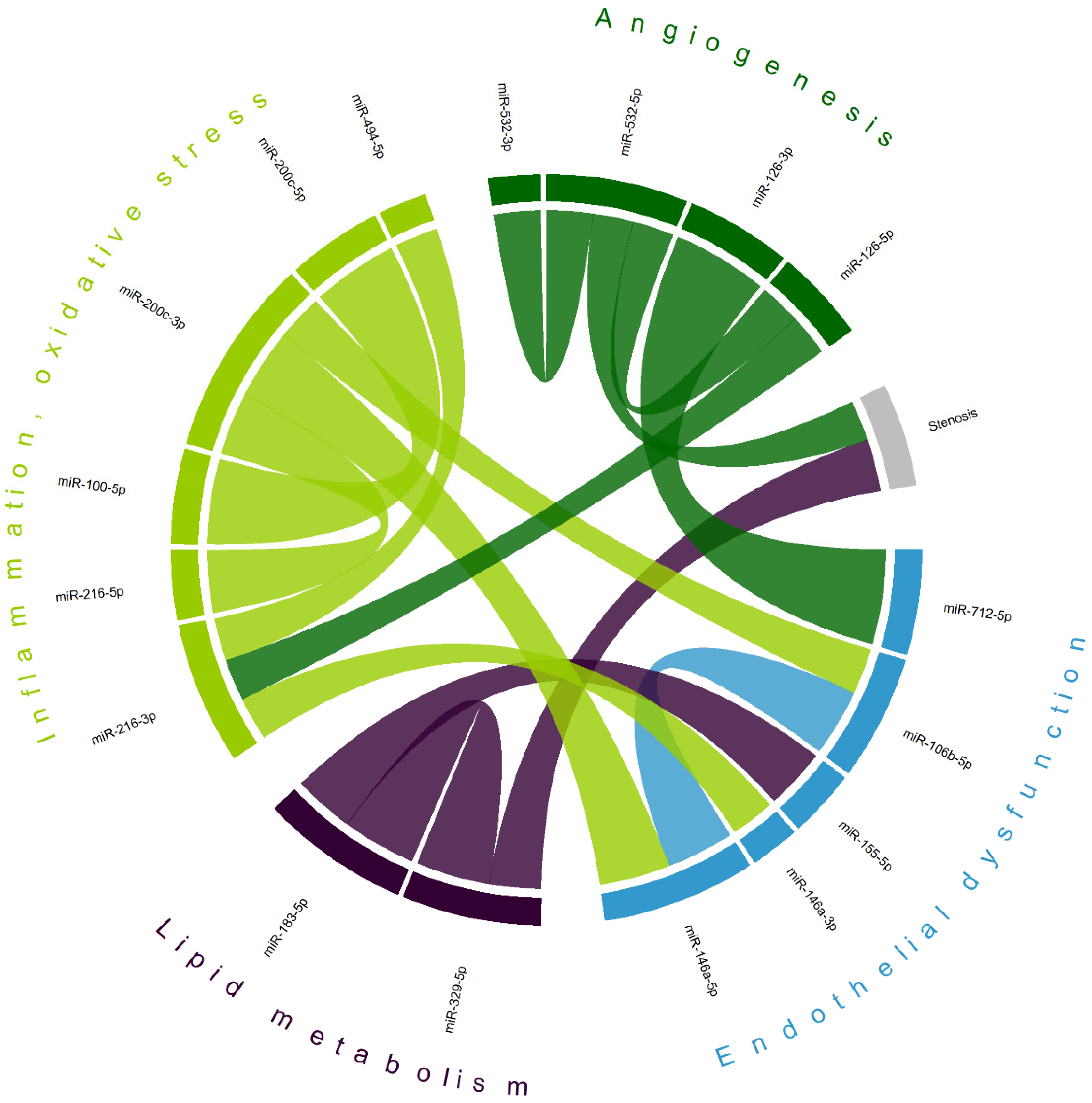Circulating microRNAs in Carotid Atherosclerosis: Complex Interplay and Possible Associations with Atherothrombotic Stroke
Abstract
:1. Introduction
2. Results
3. Discussion
4. Materials and Methods
4.1. Study Population
4.2. Laboratory Analysis
4.3. Statistical Analysis
5. Conclusions
6. Limitations
Supplementary Materials
Author Contributions
Funding
Institutional Review Board Statement
Data Availability Statement
Conflicts of Interest
References
- van Velzen, T.J.; Kuhrij, L.S.; Westendorp, W.F.; van de Beek, D.; Nederkoorn, P.J. Prevalence, predictors and outcome of carotid stenosis: A sub study in the Preventive Antibiotics in Stroke Study (PASS). BMC Neurol. 2021, 21, 20. [Google Scholar] [CrossRef] [PubMed]
- Gusev, E.; Sarapultsev, A. Atherosclerosis and Inflammation: Insights from the Theory of General Pathological Processes. Int. J. Mol. Sci. 2023, 24, 7910. [Google Scholar] [CrossRef] [PubMed]
- Song, P.; Fang, Z.; Wang, H.; Cai, Y.; Rahimi, K.; Zhu, Y.; Fowkes, F.G.R.; I Fowkes, F.J.; Rudan, I. Global and regional prevalence, burden, and risk factors for carotid atherosclerosis: A systematic review, meta-analysis, and modelling study. Lancet Glob. Health 2020, 8, e721–e729. [Google Scholar] [CrossRef] [PubMed]
- Teramoto, M.; Kokubo, Y.; Arafa, A.; Kashima, R.; Nakao, Y.M.; Sheerah, H.A.; Kataoka, H. Common Carotid Artery Stenosis Degree as a Predictor of Cardiovascular Disease in a General Population: The Suita Study. J. Am. Heart Assoc. 2024, 13, e030828. [Google Scholar] [CrossRef]
- Carballo-Perich, L.; Puigoriol-Illamola, D.; Bashir, S.; Terceño, M.; Silva, Y.; Gubern-Mérida, C.; Serena, J. Clinical Parameters and Epigenetic Biomarkers of Plaque Vulnerability in Patients with Carotid Stenosis. Int. J. Mol. Sci. 2022, 23, 5149. [Google Scholar] [CrossRef] [PubMed]
- Tang, H.; Zeng, Z.; Shang, C.; Li, Q.; Liu, J. Epigenetic Regulation in Pathology of Atherosclerosis: A Novel Perspective. Front. Genet. 2021, 12, 810689. [Google Scholar] [CrossRef]
- Tao, J.; Xia, L.; Cai, Z.; Liang, L.; Chen, Y.; Meng, J.; Wang, Z. Interaction Between microRNA and DNA Methylation in Atherosclerosis. DNA Cell Biol. 2021, 40, 101–115. [Google Scholar] [CrossRef]
- Tanashyan, M.M.; Rakurazhev, A.A.; Kuznetsova, P.I.; Mazur, A.S.; Shabalina, A.A. MicroRNA detection in carotid atherosclerosis: Prospects for clinical use. Ann. Clin. Exp. Neurol. 2023, 17, 69–74. [Google Scholar] [CrossRef]
- Magenta, A.; Cencioni, C.; Fasanaro, P.; Zaccagnini, G.; Greco, S.; Sarra-Ferraris, G.; Antonini, A.; Martelli, F.; Capogrossi, M.C. miR-200c is upregulated by oxidative stress and induces endothelial cell apoptosis and senescence via ZEB1 inhibition. Cell Death Differ. 2011, 18, 1628–1639. [Google Scholar] [CrossRef]
- Arvola, O.; Griffiths, B.; Rao, A.; Xu, L.; Pastroudis, I.-A.; Stary, C.M. Expression of miR-200c corresponds with increased reactive oxygen species and hypoxia markers after transient focal ischemia in mice. Neurochem. Int. 2021, 149, 105146. [Google Scholar] [CrossRef]
- Griffiths, B.; Xu, L.; Sun, X.; Greer, M.; Murray, I.; Stary, C. Inhibition of microRNA-200c preserves astrocyte sirtuin-1 and mitofusin-2, and protects against hippocampal neurodegeneration following global cerebral ischemia in mice. Front. Mol. Neurosci. 2022, 15, 1014751. [Google Scholar] [CrossRef] [PubMed]
- Magenta, A.; Sileno, S.; D’agostino, M.; Persiani, F.; Beji, S.; Paolini, A.; Camilli, D.; Platone, A.; Capogrossi, M.C.; Furgiuele, S. Atherosclerotic plaque instability in carotid arteries: miR-200c as a promising biomarker. Clin. Sci. 2018, 132, 2423–2436. [Google Scholar] [CrossRef] [PubMed]
- Mao, Y.; Jiang, L. MiR-200c-3p promotes ox-LDL-induced endothelial to mesenchymal transition in human umbilical vein endothelial cells through SMAD7/YAP pathway. J. Physiol. Sci. 2021, 71, 30. [Google Scholar] [CrossRef] [PubMed]
- Mukushkina, D.; Aisina, D.; Pyrkova, A.; Ryskulova, A.; Labeit, S.; Ivashchenko, A. In silico Prediction of miRNA Interactions With Candidate Atherosclerosis Gene mRNAs. Front. Genet. 2020, 11, 605054. [Google Scholar] [CrossRef] [PubMed]
- Telkoparan-Akillilar, P.; Cevik, D. Identification of miR-17, miR-21, miR-27a, miR-106b and miR-222 as endoplasmic reticulum stress-related potential biomarkers in circulation of patients with atherosclerosis. Mol. Biol. Rep. 2021, 48, 3503–3513. [Google Scholar] [CrossRef]
- Dewdney, B.; Trollope, A.; Moxon, J.; Manapurathe, D.T.; Biros, E.; Golledge, J. Circulating MicroRNAs as Biomarkers for Acute Ischemic Stroke: A Systematic Review. J. Stroke Cerebrovasc. Dis. 2018, 27, 522–530. [Google Scholar] [CrossRef]
- Li, P.; Shen, M.; Gao, F.; Wu, J.; Zhang, J.; Teng, F.; Zhang, C. An Antagomir to MicroRNA-106b-5p Ameliorates Cerebral Ischemia and Reperfusion Injury in Rats Via Inhibiting Apoptosis and Oxidative Stress. Mol. Neurobiol. 2016, 54, 2901–2921. [Google Scholar] [CrossRef]
- Mylonas, K.S.; Sarantis, P.; Kapelouzou, A.; Karamouzis, M.V.; Kapetanakis, E.I.; Kontzoglou, K.; Iliopoulos, D.C.; Nikiteas, N.; Schizas, D. Mechanosensitive Stem-Cell Genes and Klotho in Atherosclerotic Aortas: Regulating Spatially Deranged Expression Patterns Using Colchicine Regimens. J. Clin. Med. 2022, 11, 6465. [Google Scholar] [CrossRef]
- van Ingen, E.; Foks, A.C.; Kröner, M.J.; Kuiper, J.; Quax, P.H.A.; Bot, I.; Nossent, A.Y. Antisense Oligonucleotide Inhibition of MicroRNA-494 Halts Atherosclerotic Plaque Progression and Promotes Plaque Stabilization. Mol Ther Nucleic Acids. 2019, 18, 638–649. [Google Scholar] [CrossRef]
- Aavik, E.; Lumivuori, H.; Leppänen, O.; Wirth, T.; Häkkinen, S.-K.; Bräsen, J.-H.; Beschorner, U.; Zeller, T.; Braspenning, M.; van Criekinge, W.; et al. Global DNA methylation analysis of human atherosclerotic plaques reveals extensive genomic hypomethylation and reactivation at imprinted locus 14q32 involving induction of a miRNA cluster. Eur. Hear. J. 2014, 36, 993–1000. [Google Scholar] [CrossRef]
- Wezel, A.; Welten, S.M.J.M.; Razawy, W.M.; Lagraauw, H.M.M.; de Vries, M.R.; Goossens, E.A.C.B.; Boonstra, M.C.; Hamming, J.F.; Kandimalla, E.R.; Kuiper, J.; et al. Inhibition of MicroRNA-494 Reduces Carotid Artery Atherosclerotic Lesion Development and Increases Plaque Stability. Ann. Surg. 2015, 262, 841–848. [Google Scholar] [CrossRef] [PubMed]
- Zhao, H.; Li, G.; Zhang, S.; Li, F.; Wang, R.; Tao, Z.; Ma, Q.; Han, Z.; Yan, F.; Fan, J.; et al. Inhibition of histone deacetylase 3 by MiR-494 alleviates neuronal loss and improves neurological recovery in experimental stroke. J. Cereb. Blood Flow Metab. 2019, 39, 2392–2405. [Google Scholar] [CrossRef] [PubMed]
- Ling, C.; Hu, X.; Luo, L.; Liang, C.; Wang, H.; Chen, C. Phoenixin-14 regulates proliferation and apoptosis of vascular smooth muscle cells by modulation of KCNQ1OT1/miR-183-3p/CTNNB1 axis. Environ. Toxicol. Pharmacol. 2021, 86, 103655. [Google Scholar] [CrossRef] [PubMed]
- Zhu, L.; Zhou, X.; Li, S.; Liu, J.; Yang, J.; Fan, X.; Zhou, S. miR-183-5p attenuates cerebral ischemia injury by negatively regulating PTEN. Mol. Med. Rep. 2020, 22, 3944–3954. [Google Scholar] [CrossRef]
- Wen, Y.; Zhang, X.; Liu, X.; Huo, Y.; Gao, Y.; Yang, Y. Suppression of lncRNA SNHG15 protects against cerebral ischemia-reperfusion injury by targeting miR-183-5p/FOXO1 axis. Am. J. Transl. Res. 2020, 12, 6250–6263. [Google Scholar]
- Yang, S.; Mi, X.; Chen, Y.; Feng, C.; Hou, Z.; Hui, R.; Zhang, W. MicroRNA-216a induces endothelial senescence and inflammation via Smad3/IκBα pathway. J. Cell. Mol. Med. 2018, 22, 2739–2749. [Google Scholar] [CrossRef]
- Yang, S.; Li, J.; Chen, Y.; Zhang, S.; Feng, C.; Hou, Z.; Cai, J.; Wang, Y.; Hui, R.; Lv, B.; et al. MicroRNA-216a promotes M1 macrophages polarization and atherosclerosis progression by activating telomerase via the Smad3/NF-κB pathway. Biochim. Biophys. Acta (BBA)-Mol. Basis Dis. 2018, 1865, 1772–1781. [Google Scholar] [CrossRef]
- Yang, S.; Chen, Y.; Mi, X.; Zhang, S.; Yang, Y.; Hui, R.; Zhang, W. MicroRNA-216a Promotes Endothelial Inflammation by Smad7/IκBα Pathway in Atherosclerosis. Dis. Markers 2020, 2020, 8864322. [Google Scholar] [CrossRef]
- Tian, Y.S.; Zhong, D.; Liu, Q.Q.; Zhao, X.L.; Sun, H.X.; Jin, J.; Wang, H.N.; Li, G.Z. Upregulation of miR-216a exerts neuroprotective effects against ischemic injury through negatively regulating JAK2/STAT3-involved apoptosis and inflammatory pathways. J. Neurosurg. 2019, 130, 977–988. [Google Scholar] [CrossRef]
- Bettiol, A.; Urban, M.L.; Emmi, G.; Galora, S.; Argento, F.R.; Fini, E.; Borghi, S.; Bagni, G.; Mattioli, I.; Prisco, D.; et al. SIRT1 and thrombosis. Front. Mol. Biosci. 2024, 10, 1325002. [Google Scholar] [CrossRef]
- Sun, H.; Wu, S.; Sun, B. MicroRNA-532-5p protects against atherosclerosis through inhibiting vascular smooth muscle cell proliferation and migration. Cardiovasc. Diagn. Ther. 2020, 10, 481–489. [Google Scholar] [CrossRef] [PubMed]
- Liang, X.; Xu, Z.; Yuan, M.; Zhang, Y.; Zhao, B.; Wang, J.; Zhang, A.; Li, G. MicroRNA-16 suppresses the activation of inflammatory macrophages in atherosclerosis by targeting PDCD4. Int. J. Mol. Med. 2016, 37, 967–975. [Google Scholar] [CrossRef] [PubMed]
- Weber, M.; Kim, S.; Patterson, N.; Rooney, K.; Searles, C.D. MiRNA-155 targets myosin light chain kinase and modulates actin cytoskeleton organization in endothelial cells. Am. J. Physiol. Circ. Physiol. 2014, 306, H1192–H1203. [Google Scholar] [CrossRef] [PubMed]
- Liu, Y.; Qiao, F.; Wang, H. Enhanced Proteostasis in Post-ischemic Stroke Mouse Brains by Ubiquilin-1 Promotes Functional Recovery. Cell. Mol. Neurobiol. 2016, 37, 1325–1329. [Google Scholar] [CrossRef]
- Ban, R.; Huo, C.; Wang, J.; Zhang, G.; Zhao, X. Exploration of the Shared Gene Signatures and Molecular Mechanisms Between Ischemic Stroke and Atherosclerosis. Int. J. Gen. Med. 2024, 17, 2223–2239. [Google Scholar] [CrossRef]
- Murad, H.A.S.; Rafeeq, M.M.; Alqurashi, T.M.A. Role and implications of the CXCL12/CXCR4/CXCR7 axis in atherosclerosis: Still a debate. Ann. Med. 2021, 53, 1598–1612. [Google Scholar] [CrossRef]
- Ferguson, G.G.; Eliasziw, M.; Barr, H.W.K.; Clagett, G.P.; Barnes, R.W.; Wallace, M.C.; Taylor, D.W.; Haynes, R.B.; Finan, J.W.; Hachinski, V.C.; et al. The North American Symptomatic Carotid Endarterectomy Trial. Stroke 1999, 30, 1751–1758. [Google Scholar] [CrossRef]
- Zhelankin, A.V.; Stonogina, D.A.; Akselrod, A.S. Circulating platelet-derived microRNAs as potential biomarkers of STEMI in patients with hypertension. Res. Results Biomed. 2024, 10, 351–373. [Google Scholar] [CrossRef]
- Ghafouri-Fard, S.; Khoshbakht, T.; Hussen, B.M.; Abdullah, S.T.; Taheri, M.; Samadian, M. A review on the role of mir-16-5p in the carcinogenesis. Cancer Cell Int. 2022, 22, 342. [Google Scholar] [CrossRef]
- Chen, S.-S.; Tang, C.-H.; Chie, M.-J.; Tsai, C.-H.; Fong, Y.-C.; Lu, Y.-C.; Chen, W.-C.; Lai, C.-T.; Wei, C.-Y.; Tai, H.-C.; et al. Resistin facilitates VEGF-A-dependent angiogenesis by inhibiting miR-16-5p in human chondrosarcoma cells. Cell Death Dis. 2019, 10, 31. [Google Scholar] [CrossRef]
- Binderup, H.G.; Madsen, J.S.; Heegaard, N.H.H.; Houlind, K.; Andersen, R.F.; Brasen, C.L. Quantification of microRNA levels in plasma—Impact of preanalytical and analytical conditions. PLoS ONE 2018, 13, e0201069. [Google Scholar] [CrossRef] [PubMed]
- Blondal, T.; Jensby Nielsen, S.; Baker, A.; Andreasen, D.; Mouritzen, P.; Wrang Teilum, M.; Dahlsveen, I.K. Assessing sample and miRNA profile quality in serum and plasma or other biofluids. Methods 2013, 59, S1–S6. [Google Scholar] [CrossRef] [PubMed]
- Cirillo, P.D.R.; Margiotti, K.; Mesoraca, A.; Giorlandino, C. Quantification of circulating microRNAs by droplet digital PCR for cancer detection. BMC Res. Notes 2020, 13, 351. [Google Scholar] [CrossRef] [PubMed]
- Licursi, V.; Conte, F.; Fiscon, G.; Paci, P. MIENTURNET: An interactive web tool for microRNA-target enrichment and network-based analysis. BMC Bioinform. 2019, 20, 545. [Google Scholar] [CrossRef]





| Patients with CA (n = 81) | |||
|---|---|---|---|
| Parameter | Asymptomatic 1 (n = 47) | Symptomatic 1 (n = 34) | p-Value 2 |
| Age, yrs | 69 (61–74) | 67 (60–69) | 0.21 |
| Gender | 0.38 | ||
| Female | 24 (51) | 14 (41) | |
| Male | 23 (49) | 20 (59) | |
| Carotid stenosis, % | 75 (70–85) | 75 (70–80) | 0.36 |
| AH | 46 (98) | 34 (100) | >0.99 |
| DM | 13 (28) | 12 (35) | 0.46 |
| LDL, mmol/L | 1.96 (1.55–2.64) | 1.72 (1.30–2.15) | 0.087 |
| TC, mmol/L | 4.95 (4.20–5.90) | 4.20 (3.80–5.80) | 0.19 |
| Patients with CA | |||
|---|---|---|---|
| miRs | Asymptomatic 1 | Symptomatic 1 | p-Value 2 |
| miR-200c-3p | 29.7 (28.4, 31.5) | 30.6 (29.4, 33.1) | 0.047 |
| miR-200c-5p | 29.8 (25.4, 33.0) | 32.6 (28.2, 35.1) | 0.082 |
| miR-146a-3p | 26.1 (24.5, 28.2) | 26.4 (24.1, 28.1) | >0.9 |
| miR-146a-5p | 28.9 (27.8, 29.9) | 29.9 (28.0, 30.8) | 0.2 |
| miR-155-3p | 29.6 (26.9, 33.0) | 29.7 (26.8, 34.5) | 0.8 |
| miR-155-5p | 33.5 (32.2, 34.4) | 33.1 (31.6, 34.5) | >0.9 |
| miR-106b-3p | 31.7 (29.4, 34.3) | 31.3 (28.4, 35.3) | 0.9 |
| miR-106b-5p | 30.25 (29.80, 30.97) | 31.01 (30.26, 31.51) | 0.004 |
| miR-183-3p | 28.6 (26.5, 30.1) | 25.5 (22.1, 28.3) | <0.001 |
| miR-183-5p | 32.7 (29.7, 34.4) | 32.6 (31.1, 34.3) | >0.9 |
| miR-126-3p | 45 (41, 52) | 50 (43, 57) | 0.073 |
| miR-126-5p | 37.1 (34.8, 42.1) | 35.6 (33.9, 37.0) | 0.030 |
| miR-712-3p | 30.0 (26.6, 31.0) | 30.2 (26.5, 31.2) | 0.9 |
| miR-712-5p | 26.9 (23.7, 30.9) | 29.1 (24.5, 33.2) | 0.12 |
| miR-532-3p | 29.7 (26.0, 34.1) | 31.2 (27.4, 33.1) | 0.5 |
| miR-532-5p | 28.7 (26.3, 30.6) | 28.2 (26.3, 29.8) | 0.3 |
| miR-494-3p | 33.5 (29.6, 37.7) | 34.6 (31.4, 37.8) | 0.3 |
| miR-494-5p | 33 (31, 38) | 39 (36, 44) | <0.001 |
| miR-329-3p | 32.9 (29.6, 38.8) | 33.2 (28.5, 36.7) | 0.5 |
| miR-329-5p | 28 (24, 30) | 27 (25, 31) | 0.7 |
| miR-100-3p | 28.8 (25.4, 31.1) | 27.1 (24.0, 29.8) | 0.14 |
| miR-100-5p | 28.4 (23.9, 30.6) | 28.5 (23.1, 36.6) | 0.5 |
| miR-216-3p | 16.23 (14.29, 18.23) | 12.34 (11.24, 15.12) | <0.001 |
| miR-216-5p | 18.3 (16.9, 20.3) | 18.1 (16.4, 20.0) | >0.9 |
| Dependent: Stroke | OR (Univariable) | OR (Multivariable) |
|---|---|---|
| Stenosis | 1.00 (0.97–1.03, p = 0.956) | - |
| Age | 0.97 (0.92–1.02, p = 0.230) | - |
| LDL | 0.57 (0.28–1.04, p = 0.080) | - |
| miR-712-5p | 1.08 (0.99–1.19, p = 0.091) | - |
| miR-712-3p | 1.00 (0.89–1.13, p = 0.982) | - |
| miR-106b-3p | 1.01 (0.91–1.12, p = 0.831) | - |
| miR-106b-5p | 1.49 (1.12–2.41, p = 0.037) | 1.61 (1.08–2.98, p = 0.056) |
| miR-155-5p | 1.00 (0.90–1.10, p = 0.967) | - |
| miR-155-3p | 1.00 (0.92–1.09, p = 0.965) | - |
| miR-146a-3p | 0.99 (0.85–1.14, p = 0.870) | - |
| miR-146a-5p | 1.09 (0.98–1.25, p = 0.135) | - |
| miR-329-3p | 0.97 (0.90–1.04, p = 0.413) | - |
| miR-329-5p | 0.98 (0.91–1.05, p = 0.542) | - |
| miR-183-3p | 0.75 (0.63–0.87, p = 0.001) | 0.73 (0.53–0.95, p = 0.030) |
| miR-183-5p | 0.96 (0.85–1.08, p = 0.499) | - |
| miR-216-3p | 0.67 (0.52–0.82, p < 0.001) | 0.63 (0.40–0.87, p = 0.013) |
| miR-216-5p | 1.01 (0.89–1.15, p = 0.879) | - |
| miR-100-3p | 0.93 (0.84–1.02, p = 0.153) | - |
| miR-100-5p | 1.02 (0.94–1.10, p = 0.616) | - |
| miR-200c-3p | 1.13 (1.01–1.29, p = 0.042) | 0.98 (0.76–1.29, p = 0.854) |
| miR-200c-5p | 1.08 (0.99–1.19, p = 0.075) | - |
| miR-494-3p | 1.05 (0.97–1.15, p = 0.253) | - |
| miR-494-5p | 1.23 (1.12–1.39, p < 0.001) | 1.36 (1.10–1.83, p = 0.016) |
| miR-532-3p | 1.02 (0.94–1.12, p = 0.617) | - |
| miR-532-5p | 0.94 (0.83–1.06, p = 0.310) | - |
| miR-126-3p | 1.06 (1.00–1.13, p = 0.054) | - |
| miR-126-5p | 0.89 (0.80–0.98, p = 0.026) | 0.82 (0.64–0.98, p = 0.067) |
Disclaimer/Publisher’s Note: The statements, opinions and data contained in all publications are solely those of the individual author(s) and contributor(s) and not of MDPI and/or the editor(s). MDPI and/or the editor(s) disclaim responsibility for any injury to people or property resulting from any ideas, methods, instructions or products referred to in the content. |
© 2024 by the authors. Licensee MDPI, Basel, Switzerland. This article is an open access article distributed under the terms and conditions of the Creative Commons Attribution (CC BY) license (https://creativecommons.org/licenses/by/4.0/).
Share and Cite
Tanashyan, M.M.; Shabalina, A.A.; Annushkin, V.A.; Mazur, A.S.; Kuznetsova, P.I.; Raskurazhev, A.A. Circulating microRNAs in Carotid Atherosclerosis: Complex Interplay and Possible Associations with Atherothrombotic Stroke. Int. J. Mol. Sci. 2024, 25, 10026. https://doi.org/10.3390/ijms251810026
Tanashyan MM, Shabalina AA, Annushkin VA, Mazur AS, Kuznetsova PI, Raskurazhev AA. Circulating microRNAs in Carotid Atherosclerosis: Complex Interplay and Possible Associations with Atherothrombotic Stroke. International Journal of Molecular Sciences. 2024; 25(18):10026. https://doi.org/10.3390/ijms251810026
Chicago/Turabian StyleTanashyan, Marine M., Alla A. Shabalina, Vladislav A. Annushkin, Andrey S. Mazur, Polina I. Kuznetsova, and Anton A. Raskurazhev. 2024. "Circulating microRNAs in Carotid Atherosclerosis: Complex Interplay and Possible Associations with Atherothrombotic Stroke" International Journal of Molecular Sciences 25, no. 18: 10026. https://doi.org/10.3390/ijms251810026






